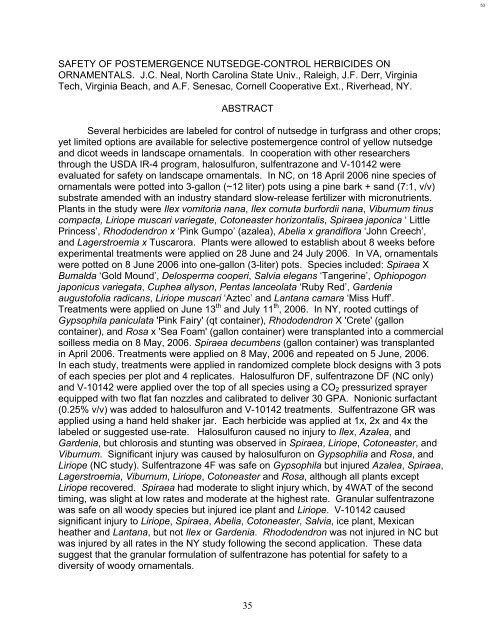Proceedings of the Sixty-first Annual Meeting of the Northeastern ...
Proceedings of the Sixty-first Annual Meeting of the Northeastern ...
Proceedings of the Sixty-first Annual Meeting of the Northeastern ...
You also want an ePaper? Increase the reach of your titles
YUMPU automatically turns print PDFs into web optimized ePapers that Google loves.
53<br />
SAFETY OF POSTEMERGENCE NUTSEDGE-CONTROL HERBICIDES ON<br />
ORNAMENTALS. J.C. Neal, North Carolina State Univ., Raleigh, J.F. Derr, Virginia<br />
Tech, Virginia Beach, and A.F. Senesac, Cornell Cooperative Ext., Riverhead, NY.<br />
ABSTRACT<br />
Several herbicides are labeled for control <strong>of</strong> nutsedge in turfgrass and o<strong>the</strong>r crops;<br />
yet limited options are available for selective postemergence control <strong>of</strong> yellow nutsedge<br />
and dicot weeds in landscape ornamentals. In cooperation with o<strong>the</strong>r researchers<br />
through <strong>the</strong> USDA IR-4 program, halosulfuron, sulfentrazone and V-10142 were<br />
evaluated for safety on landscape ornamentals. In NC, on 18 April 2006 nine species <strong>of</strong><br />
ornamentals were potted into 3-gallon (~12 liter) pots using a pine bark + sand (7:1, v/v)<br />
substrate amended with an industry standard slow-release fertilizer with micronutrients.<br />
Plants in <strong>the</strong> study were Ilex vomitoria nana, Ilex cornuta burfordii nana, Viburnum tinus<br />
compacta, Liriope muscari variegate, Cotoneaster horizontalis, Spiraea japonica ‘ Little<br />
Princess’, Rhododendron x ‘Pink Gumpo’ (azalea), Abelia x grandiflora ‘John Creech’,<br />
and Lagerstroemia x Tuscarora. Plants were allowed to establish about 8 weeks before<br />
experimental treatments were applied on 28 June and 24 July 2006. In VA, ornamentals<br />
were potted on 8 June 2006 into one-gallon (3-liter) pots. Species included: Spiraea X<br />
Bumalda ‘Gold Mound’, Delosperma cooperi, Salvia elegans ‘Tangerine’, Ophiopogon<br />
japonicus variegata, Cuphea allyson, Pentas lanceolata ‘Ruby Red’, Gardenia<br />
august<strong>of</strong>olia radicans, Liriope muscari ‘Aztec’ and Lantana camara ‘Miss Huff’.<br />
Treatments were applied on June 13 th and July 11 th , 2006. In NY, rooted cuttings <strong>of</strong><br />
Gypsophila paniculata 'Pink Fairy' (qt container), Rhododendron X 'Crete' (gallon<br />
container), and Rosa x 'Sea Foam' (gallon container) were transplanted into a commercial<br />
soilless media on 8 May, 2006. Spiraea decumbens (gallon container) was transplanted<br />
in April 2006. Treatments were applied on 8 May, 2006 and repeated on 5 June, 2006.<br />
In each study, treatments were applied in randomized complete block designs with 3 pots<br />
<strong>of</strong> each species per plot and 4 replicates. Halosulfuron DF, sulfentrazone DF (NC only)<br />
and V-10142 were applied over <strong>the</strong> top <strong>of</strong> all species using a CO 2 pressurized sprayer<br />
equipped with two flat fan nozzles and calibrated to deliver 30 GPA. Nonionic surfactant<br />
(0.25% v/v) was added to halosulfuron and V-10142 treatments. Sulfentrazone GR was<br />
applied using a hand held shaker jar. Each herbicide was applied at 1x, 2x and 4x <strong>the</strong><br />
labeled or suggested use-rate. Halosulfuron caused no injury to Ilex, Azalea, and<br />
Gardenia, but chlorosis and stunting was observed in Spiraea, Liriope, Cotoneaster, and<br />
Viburnum. Significant injury was caused by halosulfuron on Gypsophilia and Rosa, and<br />
Liriope (NC study). Sulfentrazone 4F was safe on Gypsophila but injured Azalea, Spiraea,<br />
Lagerstroemia, Viburnum, Liriope, Cotoneaster and Rosa, although all plants except<br />
Liriope recovered. Spiraea had moderate to slight injury which, by 4WAT <strong>of</strong> <strong>the</strong> second<br />
timing, was slight at low rates and moderate at <strong>the</strong> highest rate. Granular sulfentrazone<br />
was safe on all woody species but injured ice plant and Liriope. V-10142 caused<br />
significant injury to Liriope, Spiraea, Abelia, Cotoneaster, Salvia, ice plant, Mexican<br />
hea<strong>the</strong>r and Lantana, but not Ilex or Gardenia. Rhododendron was not injured in NC but<br />
was injured by all rates in <strong>the</strong> NY study following <strong>the</strong> second application. These data<br />
suggest that <strong>the</strong> granular formulation <strong>of</strong> sulfentrazone has potential for safety to a<br />
diversity <strong>of</strong> woody ornamentals.<br />
35
















